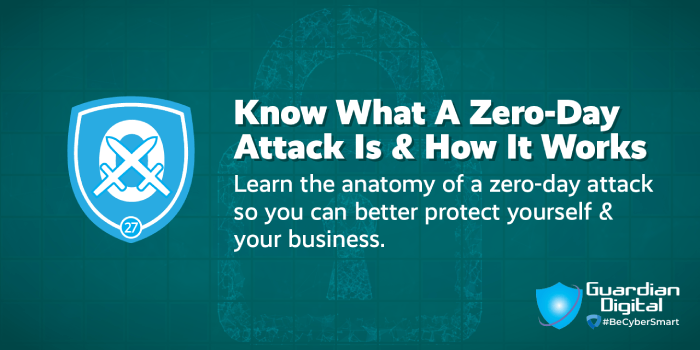Tip - Know What Zero-Day Attack Is & How It Works

Learn the anatomy of a zero-day attack so you can better protect yourself & your business.
What is a Zero-Day Attack?
“Zero-day” describes the threat of unknown or unaddressed security vulnerabilities in software or applications. Zero-day attacks are especially dangerous because the only people who know about them are the attackers. Once they have infiltrated a network, criminals can either attack immediately or sit and wait for the optimal time to do so.
Thus, attacks that exploit zero-day vulnerabilities often occur without users’ knowledge and can carry hefty costs for organizations in the form of lost productivity, data theft, system downtime, reputation damage, and regulatory actions. While these attacks frequently target high-profile businesses and governments, no organization is safe from this threat.
Watch: Anatomy of a Zero-Day Attack
How Do Zero-Day Attacks Happen?
Phase 1: Looking for Vulnerabilities
Attackers search for vulnerabilities in code, experiment with popular applications, or purchase vulnerabilities on the black market.
Phase 2: Exploit Code Created
Cybercriminals create a malware program or other technical means to exploit the vulnerability they’ve found or bought.
Poorly written code, unencrypted data or weak password security are examples of exploited vulnerabilities.
Phase 3: Affected Systems Identified
Threat actors identify systems impacted by this vulnerability using methods such as bots or automated scanners.
Some software vulnerabilities may only impact Apple macOS, making Microsoft Windows and Linux users ineffective targets.
Phase 4: Planning
Attackers determine the best way to penetrate vulnerable systems, most often leveraging phishing campaigns to do so.
Phase 5: Infiltration
The malicious actors get through the perimeter defenses of an organization or personal device.
Phase 6: Attack Launched
Attackers are now able to execute code remotely on the compromised machine to steal sensitive data.
How Can Zero-Day Attacks Be Prevented?
Use an advanced, proactive email security solution.
Traditional antivirus software is typically only effective in defending against known threats and, as a result, is often ineffective in protecting against zero-day exploits. When it comes to zero-day attack detection and prevention, every second matters! Only the most proactive, intuitive security solutions can prevent zero-day attacks using advanced AI and heuristics techniques to search for abnormal patterns not typically seen from a user or application. These advanced solutions can then develop fixes using AI (along with human intervention) and distribute them quickly and efficiently. Invest in a high-quality, comprehensive cloud email security solution capable of protecting against zero-day attacks and distributing and implementing fixes for zero-day vulnerabilities rapidly -- it will pay off!
Educate users.
Many zero-day attacks capitalize on human error. Thus, user education is imperative in preventing these exploits. Teach employees and users good security habits, tips, and best practices that will help keep them safe online and protect your organization from zero-day exploits and other digital threats.
Deploy a web application firewall.
Deploying a web application firewall will help your company react to threats in real time. A web application firewall continually scans incoming data for threats, providing organizations with the information necessary to suppress suspicious activity and stop an impending attack from occurring.
Implement network access control.
Network access control is a tool that prevents unauthorized machines from accessing an organization’s network, decreasing the risk of hacks, exploits, and breaches. It can also help to contain any damage to a particular network.
Use IPsec.
IPsec encrypts and authenticates all network traffic, allowing a system to identify and isolate non-network traffic and suspicious activity rapidly. With this information, organizations stand a better chance of recognizing and stopping attacks before damage is done.
Keep Learning About Zero-Day Attacks
- Implementing a comprehensive email security system can help prevent advanced threats, such as targeted spear phishing and ransomware.
- Following these best practices, you can also Improve your email security posture to protect against attacks.
- Keep the integrity of your email safe by securing the cloud with spam filtering and enterprise-grade anti-spam services.
- Get the latest updates on how to stay safe online.
CyberSecurity Month
- Tip - Avoid Phishing Emails
- Tip - Being Cautious of Spam Email
- Tip - Be Wary of Malicious URLs
- Tip - Protect Against Spoofing & Sender Fraud
- Tip - Protect the Privacy of Your Email with TLS
- Tip - Don't Rely on Native Microsoft 365 Email Protection Alone
- Tip - Implement TLS to Keep Your Email Secure
- Tip - Endpoint Security Is Not Enough
- Tip - Conduct Regular Email Security Audits
- Tip - Configure Email Account Settings with Security in Mind
- Tip - Learn How To Spot Threats to Business Email
- Tip - Backing up Your Data and Isolate Your Backups Offline
- Tip - Protect Business Email from Phishing Attacks
- Avoid Sending Sensitive Information Over Email
- Tip - Learn About Malicious Links
- Tip - Prevent Zero-Day Attacks
- Tip - Business Email Is for Business Only
- Tip - Learn How To Identify Social Engineering Attacks
- Tip - Know Your Email Risk
- Tip - Safeguard Your Inbox from Malicious Mail
- Tip - Understand How Phishing Attacks Are Carried Out
- Tip - Know the Steps in a Spear Phishing Attack
- Tip - Familiarize Yourself with the Anatomy of a Whaling Attack
- Tip - Understand How Malware Attacks Work
- Tip - Learn the Steps in a Ransomware Attack
- Tip - Understand the Phases of a Business Email Compromise (BEC) Attack
- Tip - Know What Zero-Day Attack Is & How It Works
- Tip - Familiarize Yourself with the Phases of an Account Takeover (ATO) & Lateral Phishing Attack
- Tip - Learn the Steps in a Social Engineering Attack
- Tip - Understand the Types of Email Viruses to Be on the Lookout For